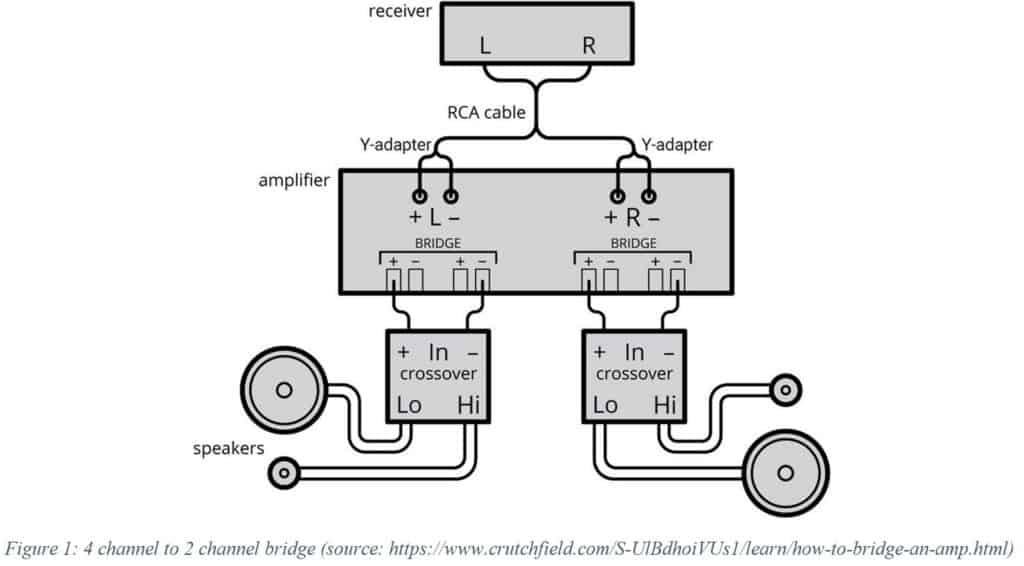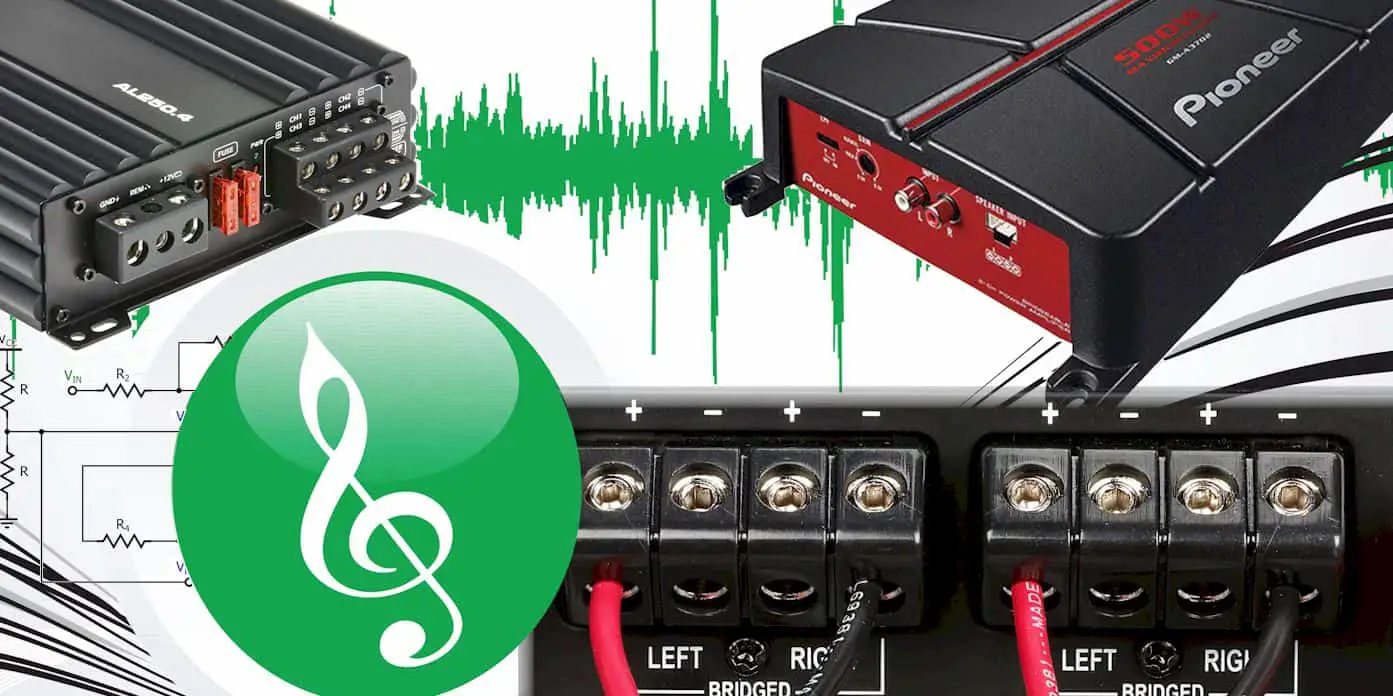Do you love to listen to music while driving? It’s a great companion to your long drives, without any doubt. So, if you want to enhance and boost your experience of listening to music in your car, you can try out bridging the amp.
Don’t know how to bridge an amp? Or maybe you have heard about bridging for the first time. Well, either way, you are in for a wonderful ride. Here, I will tell you all about bridging and how you can do it with your car amplifier.
Let’s get this started right away.
Contents
Understanding the “Bridging an amp.”
Before you even get into the process, let’s go ahead and see why you should even try bridging. Doing something without knowing the purpose is just pointless, right?
What is bridging?
So, what does “bridging an amp” mean? In simple terms bridging an amplifier converts the spread-out power into a single power source, so you get more power from the single source.
For example, when you have a 4-channel amplifier, you can convert that to a 2-channel amplifier. This will make the 2-channel amplifier much more powerful. The process of this conversion is known as amp bridging.
What does bridging an amp do?
Bridging is a process that gets you more power to your sound system using an amp. Generally, you can bridge a two-channel amp to one channel to get some extra power. Think of it like this; there are two channels available that can power two channels.
But you decide to use the power of both the channels into a single one; wouldn’t that give that single channel some extra boost?
In the same way, you can do that to a 4-channel amp. You can bridge a 4-channel amp to a 2-channel sound system to get more power. The working process of both these things is similar.
Related: How to Play CDs In Newer Cars Without CD Player
When and why bridge an amp?
It’s usually done when you don’t need the 4 amplifier channels for the spread-out music. Rather you want to focus all the music on one source.
The real question here is why you would do this, and does this involve any risk? Well, the answer is, it doesn’t have any risk when you know the proper ways.
And to answer the first question, wouldn’t you love to have some extra boost from your subwoofer in your car music. If you would, then you definitely should try out bridging an amp. It can give you double the power your sound system currently has.
To top it off, if you want to boost up your car’s music system, you can try out bridging the amp. There are several ways to do so.
I will take you through two of them. One uses a 4-channel to 2-channel bridging, and the other one is 2-channel to 2 subs bridging.
Let’s get rolling. I will share some diagrams as well, so you can follow along without any trouble.
How to bridge a 4-channel amp to 2 channels
If you have a 4-channel amp and want to bridge that to 2 channels, you can follow these steps.
Identify the amplifier
Identifying the amplifier means finding out if your amp is bridgeable or not. Because otherwise, you will be wasting all your time and may even damage the existing amp with the wrong wiring.
Whether an amp is bridgeable or not is usually described in the manual. If you don’t have it, you can search on the internet with the model number of the amp, and you will see it there. If it’s bridgeable, you can go to the next step.
Check the layout of the amp.
Before you start wiring things, look at the panel of the amp first. In a four-channel amp, there are usually eight terminals. Two terminals make up a single channel. And two channels combined make up one speaker output. These two channels are the left channel and right channel of speakers that you know.
The indication uses a red and black color combo. Here the red ones are typically positives, and the black ones are negative.
On every channel, you will have one positive and one negative terminal. Every terminal may or may not have labels. If not, then you should create your map and labels for the terminals. For example, you can use A, B, C, D, and so on.
Related: Why not recommend mounting amps to sub boxes
Connecting the amp to speakers
Now, it’s time to work with the speakers. Your speakers will have two wires, one positive and one negative. Usually, it matches the colors I talked about earlier—the red is positive, and the black one is negative.
So, now you have to connect the positive wire to the first channel on the first terminal, in my case, the A terminal. Then, you have to connect the negative wire to the 2nd terminal of the 2nd channel, which is the D terminal.
To connect the wires, you have to unscrew the screws of the terminals. Some come with clips, so you can use that if that’s your case. Just make sure to secure the wires tightly so they don’t come off.
Now following this same method, you have to connect the second speakers as well. Just connect the positive wire to the 1st terminal or E terminal of the 3rd channel. And connect the negative wire to the 2nd terminal or H terminal of the 4th channel. That should do it for the bridging of a 4-channel amp to 2-channel.
As you can see here, you are using only one terminal on each channel. This way, the parts that are not being used will share the power to the ones that are being used. And that’s how you get a boost in the sound of your car amplifier.
Related: Play Music from Phone to Car without aux
4-channel amp wiring diagram
To make things easier for you, I will provide a 4-channel amp wiring diagram

Here, you can see there are four channels in total. This goes off to the two speaker outputs indicating Lo and Hi. As you can see from the wiring, one wire of each channel is connected to one positive terminal, and the other one is connected to the negative terminal.
So, how does this work? When you use the positive terminal of a single channel and the negative one of the other channels, you can double the output.
As each of the channels is usually capable of putting out a 2-ohm load. Using only one terminal double up that load, providing more power in wattage. This eventually optimizes your whole system giving you more usable power instead of wasting it.
Related: car sound system setup
How to bridge a 2-channel amp to 2 subs
Bridging a 2-channel amp to 2-subs is not a great idea to begin with. There are lots of mathematics that go behind why it’s not a good idea. Also, if you want this to work, you will have to go through plenty of products and look for a powerful amp to work with.
Various compatibility factors come into play here. You have to consider the ohm counts, wattage, and power capacity of every component.
Having said that, there is a way to bridge 2 channel amp to 2 subs if you have all the compatibility and power sorted out. For that, you will need an extra step of connecting the subwoofers first.
You can use a wire to connect both the amplifiers with each other. And then you can use another wire and connect that to any one of them. You will use that additional wire to bridge with the amp. The rest of the connection is similar to bridging a 2-channel amp to a single sub.
Bridging a 2-channel amp to a single sub
On the other hand, it’s very simple to bridge a 2-channel amp to a single sub. You can do that very easily, and that’s what I am going to discuss here.
Identifying amplifier
Just like I discussed previously, you have to find out if the amplifier is bridgeable or not. You can’t even attempt to bridge an amp if it doesn’t support bridging at all. So, check for this fact before anything else.
Finding out the terminals
Next up, you have to figure out the terminals of the amp. In a 2-channel amp, you should have 4 terminals in total—a positive and a negative terminal for each channel. The two channels are a left channel and a right channel for the typical stereo setup.
Connecting the subwoofer to an amplifier
The connection of the sub is pretty similar to connecting speakers. However, in the case of speakers with a 2-channel amp, bridging may not be an option. You can do bridging only with sub-woofers in that case.
So, to connect the sub, you can use the method I discussed earlier. All you have to do is get the positive wire of the sub and connect that to the first terminal of channel one. And get the negative wire of the sub, then connect it to the second terminal of the second channel.
That’s it for the connection. That’s all you need to do for bridging your subwoofer with a 2-channel amplifier.
2-channel amp wiring diagram
You can understand the whole concept better with this wiring diagram of a 2-channel amp to a single subwoofer.

As you can see here, it has got 2 different left and right channels. Aside from all the power sources, there is a subwoofer attached to it. In a regular connection, the wires will be connected to a single channel. But when you are in bridge mode, you will notice the wires are far apart.
This far apart connection is the source of all that extra power that you get from bridging an amp. Here, the left channel uses only the positive terminal, so the power from the negative terminal is unused.
Similarly, the right channel is using the negative terminal hence the positive terminal is unused. These unused terminals are the sources of that extra energy and power you get from the bridging method.
FAQ
Here are some common questions people ask about bridging car amps-
Q1: Can you bridge any amp? What are the requirements?
A: In general, any standard car amp can be bridged. However, it depends on some crucial factors as well. The first thing to consider is the Ohm units of the amp and speakers or subwoofers you use.
There are factors like impedance that have a huge role in the bridging process of an amplifier. The ohm load of your amp should match up the speakers or the subs you want to connect. So, you have to make sure of all the specifications for that.
In short, your amp needs to be bridgeable, and you can find that on the instruction manual. So, go through that thoroughly before you go on with bridging.
Q2: Does bridging ruin the amp or speakers?
A: If you maintain the power usage and ohm impedance under control, it shouldn’t have any negative impact. For example, if you want to bridge a 600-watt unit but have a 300-watt amp, you can easily ruin your amp. It will overheat and then burn out completely.
Also, make sure to check up on the ohm impedance. If you have a 4 Ohm amp, you can go for two 2-ohm speakers. But if you have a 2ohm amp, then going for the same speakers won’t cut it for you.
Related: Kenwood DDX9703S Review
Final words
To sum it up, knowing how to bridge an amp can be very helpful for your sound system. But knowing when to do it and when to stop is equally important. When you go with the wrong ohm load, compatibility, impedance, power usage, you can ruin all your equipment at once. So, before you approach the process, make sure you go through proper research of the compatibility. You must be sure of the components you are using. Otherwise, it only harms you and your system. Successful bridging could lead to great results for your sound system, and you will love the experience.

Graduated with a Bachelor of Audio Engineering and Sound Production. He has worked with a number of studios as a Recording Engineer, with over 10 years of servicing experience in both re-recording mixing and sound editing.

